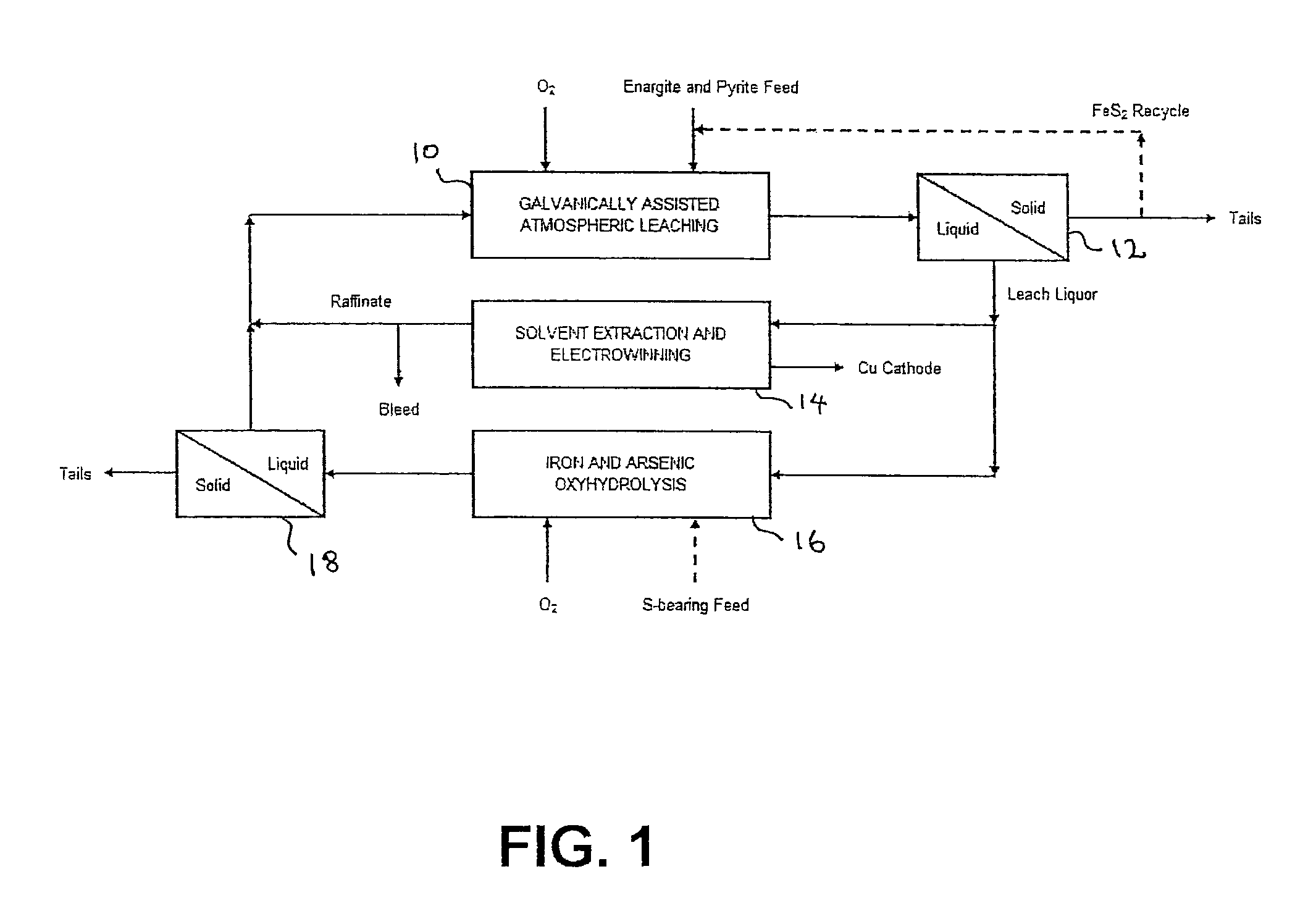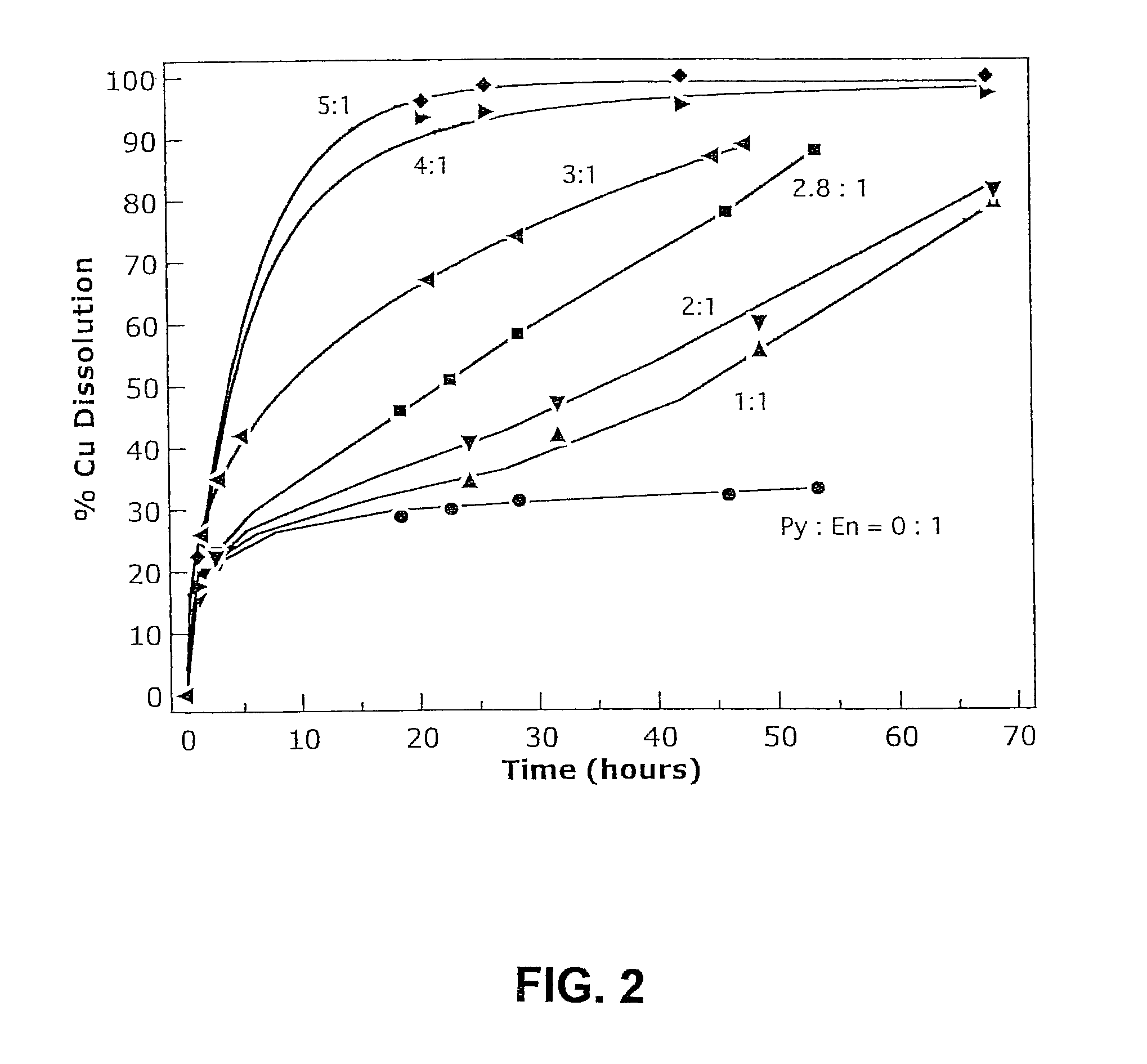Leaching process for copper concentrates containing arsenic and antimony compounds
a technology of arsenic and antimony compounds and leaching process, which is applied in the direction of separation process, dissolution, copper sulfate, etc., can solve the problems of difficulty in recovering copper from such minerals and paying penalties
- Summary
- Abstract
- Description
- Claims
- Application Information
AI Technical Summary
Benefits of technology
Problems solved by technology
Method used
Image
Examples
example 1
[0035]Copper leaching tests were performed on samples of a nearly pure enargite (En) sample (from the Leonard Mine near Butte, Mont.), which contained 41% copper (pure ideal enargite contains 46.1% copper) with additions of nearly pure pyrite (from the Huanzala district of Peru). Six tests were run in 1600 mL of solution under identical conditions (480 mV vs Ag / AgCl, 80° C., 20 g total dissolved Fe, 60 g total H2SO4, oxygen gas, 1200 rpm agitation speed). 25 g of the enargite sample was used in each test with mass additions of pyrite (Py) in the following seven pyrite to enargite ratios: 0:1, 1:1, 2:1, 2.8:1, 3:1, 4:1 and 5:1, corresponding to pyrite concentrations of approximately 0, 16, 31, 44, 47, 63 and 78 g / L respectively. The copper extraction was measured at intervals. The results are shown in FIG. 2.
[0036]In the absence of pyrite, the leach rate reached a plateau after about 30 hours, with less than 30% of the copper extracted. Increasing the pyrite to enargite mass ratio ha...
example 2
[0037]A copper leaching test was run on a 180 g sample of concentrate having the following mineral composition:
[0038]
MineralIdeal FormulaMass %ChalcopyriteCuFeS218.5PyriteFeS242.4TennantiteCu12As4S135.4Sphalerite(Zn,Fe)S25.8GalenaPbS0.2AnglesitePbSO42.3PlagioclaseNaA1Si3O8—CaA12Si2O81.8QuartzSiO21.4GypsumCaSO4•2H2O2.2Total100
[0039]The test was run in 1600 mL of solution under the following conditions: 480 mV vs Ag / AgCl, 80° C., 20 g total dissolved Fe, 80 g total H2SO4, oxygen gas, 1200 rpm agitation speed. Based on the ideal mineral formulae given above, approximately 29% of the Cu in the sample occurred as tennantite (Tn), and the remaining 71% occurred as chalcopyrite (Cp). The chalcopyrite was leached rapidly (within about 20 hours) at the prevailing pyrite (Py) content of 42.4%, or approximately 48 g / L pyrite concentration, but tennantite failed to leach significantly during the first 58 hours of the test, and was only about half leached when the test was terminated after 70 ho...
PUM
| Property | Measurement | Unit |
|---|---|---|
| concentration | aaaaa | aaaaa |
| concentration | aaaaa | aaaaa |
| concentration | aaaaa | aaaaa |
Abstract
Description
Claims
Application Information
 Login to View More
Login to View More - R&D
- Intellectual Property
- Life Sciences
- Materials
- Tech Scout
- Unparalleled Data Quality
- Higher Quality Content
- 60% Fewer Hallucinations
Browse by: Latest US Patents, China's latest patents, Technical Efficacy Thesaurus, Application Domain, Technology Topic, Popular Technical Reports.
© 2025 PatSnap. All rights reserved.Legal|Privacy policy|Modern Slavery Act Transparency Statement|Sitemap|About US| Contact US: help@patsnap.com



